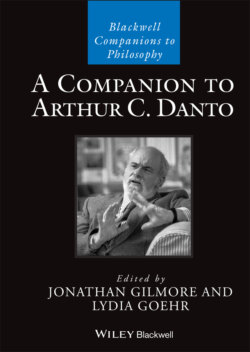Читать книгу A Companion to Arthur C. Danto - Группа авторов - Страница 15
Working with Arthur C. Danto Michael Kelly
ОглавлениеI first met Arthur in person when I was being interviewed in 1986 for the Managing Editor position at the Journal of Philosophy at Columbia University (he was President of the Journal). The second, informal interview took place at the December annual meeting of the American Philosophical Association, held that year in Boston. Arthur suggested that we meet at the Institute of Contemporary Art, located at the time next to a fire station on Boylston Street. When I arrived, Arthur was talking to a few friends, so I waited, thinking we would be meeting alone. But he called me over and introduced me to Nelson Goodman and Richard Wollheim, who were standing in front of a contemporary work on paper by David Salle. If Goodman was wondering when the work was art, if it were, and if Wollheim was closely seeing in the work hoping to discern it as whatever the artist intended it to be, Arthur was mischievously disinterested in making any aesthetic judgment of it, though he was already an art critic for The Nation. He was instead trying to understand what could account for the work’s ontological status as art. It embodied meaning, he divined, even if the meaning it embodied were largely to provoke vexing questions about art among some of the world’s leading experts at the time. Whether good or bad, Salle’s work corroborated Arthur’s definition of art as embodied meaning, to which he added “wakeful dreams” as a third criterion in his last, recently published book, What Art Is.
I worked closely and fortunately with Arthur for sixteen years. In the long run, however, he ruined my life as an employee, and I told him this because he was so generous, judicious, and respectful that I came to expect similar treatment everywhere else I have worked since leaving Columbia. If I have not found it in other employment situations, and if I have not developed the same leadership qualities on my own, both are less a criticism of others, myself included, than confirmation of how special Arthur was in this regard. Should there be an afterlife, Arthur should be president, even if work is not required.
At the same time, Arthur had an uncanny, enviable ability to deflect any criticism of his philosophy, and perhaps of his person too. While he could seem aloof in doing so, he was really returning the criticisms to the senders, cleverly inviting them to think instead about their own ideas. Any such exchange with Arthur was an opportunity, hopefully characterized by wit and erudition on the interlocutor’s side, too, for each person to become clearer about her ideas, not simply as one’s own but as ideas. This is perhaps why Arthur did not have many, if any, students in the typical academic way that a prominent philosopher might foster students to develop and sustain his theories. Rather, he encouraged independent thinking, which was his gift as a teacher and friend.
Turning back to art, it is still hard to forget the image of Arthur, forty years old, standing amidst the stacks of Brillo pad, Delmonte peach, Heinz ketchup, and other cartons in the Stable Gallery in April 1964, where he famously had his epiphany about art. None of it made any sense to him as art, though he was a relatively successful practicing artist, making wood-block prints in an expressionist or mannerist style while also teaching philosophy at Columbia. He stopped making art roughly around the time of the Stable show, I believe, for he decided he could no longer continue doing both art and philosophy. Why did he choose philosophy? Because more than art alone, philosophy enabled him to make sense of the art that did not make any sense. But first, since he determined that no existing definition or philosophy of art could explain why Warhol’s Brillo boxes were art when their supermarket equivalents were not, Arthur had to discover a new definition, which he somehow found in those boxes and which anchored his essentialist philosophy of art for forty-nine years, and beyond.
Arthur is and will remain exemplary, as a philosopher and critic, because of the way he understood the intimate relationship between philosophy and art, and especially because of his insistence that the philosophy of art be calibrated to contemporary practice, and not just to Warhol’s or Salle’s work. Whether or not people agree with Arthur’s philosophy of art, they should appreciate that he worked harder than anybody, perhaps ever, to correct philosophy’s tendency to disenfranchise art because it allegedly steals our attention and diverts us from truth. He always believed, despite the postmodern turn in culture contemporaneous with his Stable epiphany, that philosophy’s ultimate goal was still truth. But he also thought that at times it could not achieve that goal without art. After all, knowing the essence of art is a way of knowing truth, and, he argued, this truth is revealed only by art, though it then had to be articulated by philosophy. It turns out that art discloses something about the nature of truth, and not just in relation to art, for truth is truth.
Like Baudelaire and Hegel, a fusion of writer and thinker Arthur embodied in many ways, he believed you could find the universal truth about art only in its contemporary embodiments, for that is where such truth lives. That is also where Arthur lived, and where we will always find him, playfully and generously philosophical as ever.
Figure 4 Reproduced with permission of Lydia Goehr.
